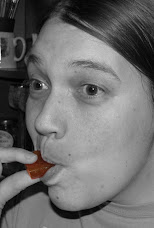But until today, I did not know about the science behind the process. So grab your scoops and sundae bowls and prepare for a tasty lesson about the science of ice cream!
I made ice cream with two plastic freezer bags
and a depressed freezing point. With stuff around the house.
For this fun project, you need the following:
1 gallon freezer bag
1 quart freezer bag
Ice cubes
Large crystal salt
Ingredients:
1 cup milk -OR- Half and Half -OR- whipping cream
(These vary in creaminess and the amount of exercise required post-ingestion.)
2 tbs. sweetener - you can use regular sugar - I used agave nectar.
2 tbs. sweetener - you can use regular sugar - I used agave nectar.
1 tsp. flavoring - any kind you like. I went with regular old vanilla.
First you mix the milk, sweetener and flavoring in the quart-sized bag.
Congratuations! You've just created a solution!
(No, not the "problem" kind of solution. Unless you're thirsty for flavored, sweetened milk.)
The solution I'm talking about is a homogenous mixture of two or more substances. *cricket chirp* OK, so science isn't my strong suit, and the first time I read the definition of a solution I was thinking, "Um - What?" (Oh, to challenge my limitations!) I know the everyday meaning of homogenous, and the scientific one isn't much different. Homogenous, in this case, means that these ingredients are now combined in a uniform substance. After you mix it together fully, the components do not settle or separate on their own, i.e. the vanilla won't rise to the top, the sugar won't settle to the bottom. While the milk, sugar, and vanilla retain their own chemical uniqueness, they have come together to create a new substance. When they join together, they create a solution! (Hey, if you need a speech at an ice cream social feel free to take that and run with it.)
And with that little tidbit of information, I now also understand homogenized milk. During that process, the fat molecules that would normally rise to the top and separate from the milk are shot through teeeeeny-tiny holes so that they will be small enough to intermix with the rest of the milk. Here's a link that explains the process.
So, wait a sec. They infuse the fat molocules into the milk? Hmm. I wonder if that's why the milk with the cream that rises to the top tastes better... It seems I'll have to take my blog on a field trip to the local creamery when the weather gets a little nicer.
Ok, back to the ice cream science...
I always wondered as a kid why they added the salt. The grown-ups told me it was because it melted the ice. But I found a more in-depth explanation at this site. "When you add salt to the ice, it lowers the freezing point of the ice, so even more energy has to be absorbed from the environment in order for the ice to melt. This makes the ice colder than it was before, which is how your ice cream freezes."
This is also why it's important to salt the roads when it starts to get icy, and why parts of the ocean don't freeze even when they are well below freezing. This site is really interesting and explains it well.
Next, add the WeLL-SEALED bag of milk solution.
And add 1/4 more ice and 3 more tbs. of salt on top.
And now comes the fun part. You shake the bag for about five minutes. This is where you can get the kids involved and make them do the work. They can play catch with it, or hula hoop with it in their hands, or do cartwheels with it in their teeth. Just as long as it keeps shaking. My kids were sleeping when I did it, so it wasn't nearly as entertaining as it might have been. My hands started getting cold, too.
As frostbite started claiming my fingers, I thought it might be brilliant to try sticking it in the washing machine and letting that agitate it. But I remembered it doesn't agitate without water. Then I thought I could toss it in the dryer on air-only cycle. But then I imagined the seals not holding up against such vigorous mixing and then imagined my husband's face when I explained the reason why we needed a new dryer.
"Well, sweetie. I was going to make ice cream . . . "
"Ice cream?"
"Yeah, ice cream."
"What's that got to do with the dryer?"
"Well, I had to keep shaking it, and my hands got cold . . . "
"So you put the ice cream in the dryer?"
"Um, yes. Well, it seemed like a good idea at the time."
"In the dryer?"
"Yeah! Think of all the people that would read a post entitled, 'Today I learned to make ice cream in my dryer.' You have to admit that sounds intriguing."
"As opposed to 'Today I learned how to install a clothesline in my living room because I tried to make ice cream in my dryer.'"
So, readers, be warned that this is the direction your mind can go when your hands start freezing because you are making ice cream in Ziploc bags after everyone has gone to sleep. Fortunately, these thoughts can be easily assuaged by A.) a pair of mittens or B.) a pillowcase. I chose the pillowcase because it was fun to swing around in circles.
Speaking of ice-cream induced mental impairments here's more science as
So, after my five minutes were up, I checked out the bag of ice cream:
I scream - you scream - we all scream for ice cream!
Now you just serve it up. I recommend cutting one of the corners and squeezing it out soft-serve style. And if you have any aspirations of ice cream photography be sure that your batteries are at max power, because sundaes tend to pout if they're kept waiting.
But they are still tasty.
I learned a lot more science about ice cream,
like crystallization, emulsification and pasteurization.
like crystallization, emulsification and pasteurization.
And I learned that ice cream made in a bag
is just as tasty as the stuff from the store.
is just as tasty as the stuff from the store.
I'll post my next lessons on Sunday evening
since I'll be offline for a bit.
since I'll be offline for a bit.
I'll keep you posted!
*No dryers were harmed in the making of this post.*


















3 comments:
When I was growing up the only time we had homemade ice cream was in the winter because my Mom used snow around the outside of the container instead of ice. Not sure why because most people have stories of having homemade ice cream in the summmer but no not me! We used to get so excited when we had our first measurable snow because we knew we'd get ice cream! :)
Love this post! I use agave often, what a great sub for ice cream! :)
seriously?!?! no fancy schmancy machine needed- totally doing this!!!
Post a Comment
You put your input in! You take some insight out! You put your input in and you shaaake it all abooout...